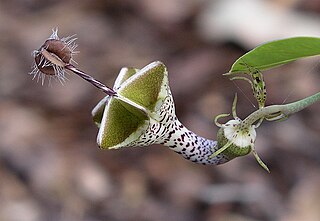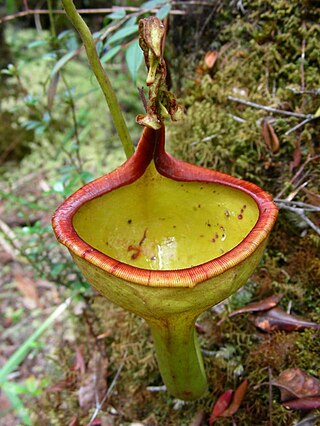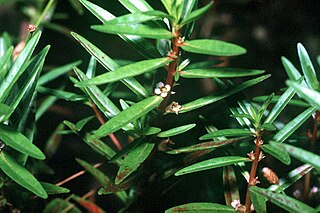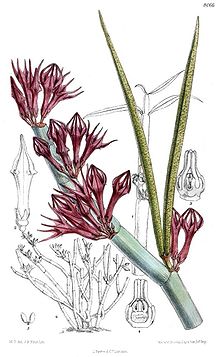
Ceropegia is a genus of plants within the family Apocynaceae, native to Africa, southern Asia, and Australia. It was named by Carl Linnaeus, who first described this genus in his Genera plantarum, which appeared in 1737. Linnaeus referred to the description and picture of a plant in the Horti Malabarici as the plant for which the genus was created. In 1753 he named this species as Ceropegia candelabrum. Linnaeus did not explain the etymology but later explanations stated that the name Ceropegia was from the Greek word keropegion κηροπηγɩον. This means candelabrum in Latin, which has a broader range than the modern word - "a candlestick, a branched candlestick, a chandelier, candelabrum, or also lamp-stand, light-stand, sometimes of exquisite workmanship".

Delonix regia is a species of flowering plant in the bean family Fabaceae, subfamily Caesalpinioideae native to Madagascar. It is noted for its fern-like leaves and flamboyant display of orange-red flowers over summer. In many tropical parts of the world it is grown as an ornamental tree and in English it is given the name royal poinciana, flamboyant, phoenix flower, flame of the forest, or flame tree.

Lathyrus japonicus, the sea pea, beach pea, circumpolar pea or sea vetchling, is a species of flowering plant in the legume family Fabaceae, native to temperate coastal areas of the Northern Hemisphere and Argentina.

Nepenthes fusca, or the dusky pitcher-plant, is a tropical pitcher plant endemic to Borneo. It is found throughout a wide altitudinal range and is almost always epiphytic in nature, primarily growing in mossy forest.

Nepenthes eymae is a tropical pitcher plant endemic to Sulawesi in Indonesia, where it grows at elevations of 1,000–2,000 m (3,300–6,600 ft) above sea level. It is very closely related to N. maxima, from which it differs in its wine glass-shaped upper pitchers.

Ceropegia woodii is a flowering plant in the dogbane family Apocynaceae, native to South Africa, Eswatini and Zimbabwe. It is sometimes treated as a subspecies of the related Ceropegia linearis, as C. linearis subsp. woodii. Common names include chain of hearts, collar of hearts, string of hearts, rosary vine, hearts-on-a-string, and sweetheart vine.

Ceropegia dichotoma is a flowering plant in the genus Ceropegia (Apocynaceae). It is endemic to the Canary Islands, where it grows on Tenerife, El Hierro, La Gomera, and La Palma in the Tabaibal-Cardonal zone at up to about 600 m altitude. It was first described in 1812.

Vinca major, with the common names bigleaf periwinkle, large periwinkle, greater periwinkle and blue periwinkle, is a species of flowering plant in the family Apocynaceae, native to the western Mediterranean. Growing to 25 cm (10 in) tall and spreading indefinitely, it is an evergreen perennial, frequently used in cultivation as groundcover.

Lathyrus sylvestris, the flat pea or narrow-leaved everlasting-pea, is a species of flowering plant in the pea and bean family Fabaceae. It is native to parts of Africa, Europe, and Asia.

Phoenix sylvestris also known as silver date palm, Indian date, sugar date palm or wild date palm, is a species of flowering plant in the palm family native to southern Pakistan, most of India, Sri Lanka, Nepal, Bhutan, Myanmar and Bangladesh. It is also reportedly naturalized in Mauritius, the Chagos Archipelago, Puerto Rico and the Leeward Islands. Growing in plains and scrubland up to 1300 m above sea level, the fruit from this palm species is used to make wine and jelly. The sap is tapped and drunk fresh or fermented into toddy. The fresh sap is boiled to make palm jaggery in West Bengal state of India and Bangladesh.

Ocotea foetens, commonly called til or stinkwood is a species of tree in the family Lauraceae. It is evergreen and grows up to 40 m tall. It is a common constituent of the laurisilva forests of Madeira and the Canary Islands. Leaf fossils of this species are known from the Mio-Pleistocene of Madeira Island.

Thryptomene micrantha, commonly known as ribbed thryptomene, is a species of flowering plant in the family Myrtaceae and is endemic to south-eastern Australia. It is a spreading to erect shrub with egg-shaped leaves, the narrower end towards the base, and white flowers with five petals and five stamens.

Rotala ramosior is a species of flowering plant in the loosestrife family known by the common name lowland rotala. This aquatic or semiaquatic plant is native to North America, where it grows in lakes, streams, and irrigation ditches. The branching stems of the plant grow to about 40 cm long. Leaves are decussate, arranged oppositely in perpendicular pairs along the stems. The leaves are linear to lance-shaped to oval and up to 5 cm long. Flowers occur singly in leaf axils. Each has triangular sepals with long, narrow appendages and usually four tiny white petals in shades of pink to white. This plant is sometimes grown in aquariums.

Solanum chilense is a plant species from the "tomato" subgenus Lycopersicon within the nightshade genus Solanum.

Globularia amygdalifolia is a flowering plant of the family Plantaginaceae. The species is endemic to Cape Verde. It is listed as an endangered species by the IUCN.

Strasburgeria robusta is an evergreen tree with large toothed leaves and large but rather inconspicuous, single, pendulant flowers in a gloomy colorscheme of yellowish with brown markings, with about ten sepals, five petals, ten stamens, a very distinct circular nectar gland with radiating spikes and rather large globular fruits with a long persistent style, with a scent reminiscent of apples, which is endemic to New Caledonia. It is the only recognized species of the genus Strasburgeria.

Hypericum undulatum, the wavy St Johns Wort, is a herbaceous perennial flowering plant native to western Europe and northern Africa. The specific name undulatum is Latin, meaning "wavy" or "undulated", referring, just as the common name, to the wavy leaf margins of the herb. The plant has a diploid number of 16 or 32.

Podranea ricasoliana, called the pink trumpet vine, is a species of flowering plant in the genus Podranea, native to South Africa, Malawi, Mozambique and Zambia. It has gained the Royal Horticultural Society's Award of Garden Merit.
Hibbertia caudice is a species of flowering plant in the family Dilleniaceae and is endemic to northern Australia. It is a shrub with wiry stems, hairy foliage, elliptic to lance-shaped leaves with the narrower end towards the base, and yellow flowers arranged in leaf axils, mostly with twenty-four to twenty-six stamens arranged in groups around the two carpels.
Hibbertia persquamata is a species of flowering plant in the family Dilleniaceae and is endemic to the Northern Kimberley region of Western Australia. It is a spreading to prostrate shrub with flattened, scaly branches, narrow elliptic leaves and yellow flowers arranged singly in leaf axils with 20 to 26 stamens arranged around three scaly carpels.


















